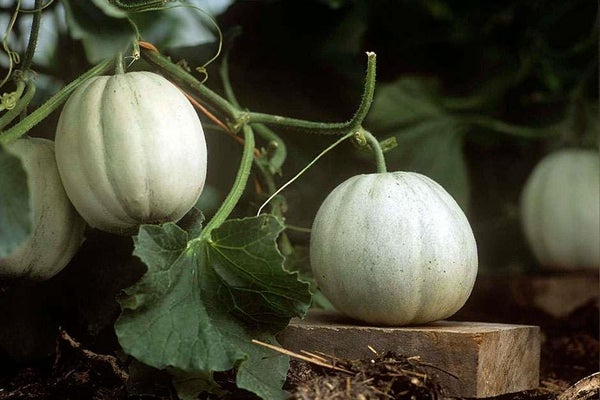
Getting Started
Melons are tender, trailing that need heat, and consistent moisture to produce their sweet, juicy, aromatic fruits. They’re best grown in a greenhouse or polytunnel, although some varieties may fruit outdoors in warm locations or under cloches. With suitable growing conditions, a single plant can produce five or six ripe melons.
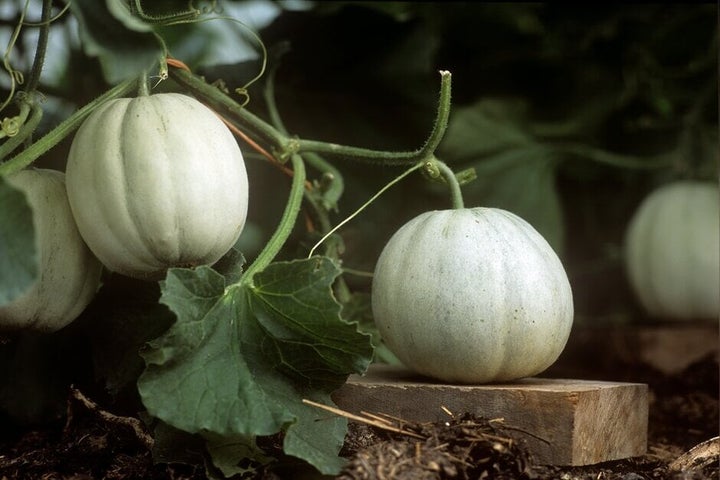
Melons (Cucumis melo) are closely related to cucumbers and have a similar style of growth, with vigorous scrambling stems, large leaves, yellow flowers and twining tendrils. In a greenhouse they are usually grown up supports to save space. Two main types of sweet melons can be grown in the UK:
- Cantaloupe melons – with rough skin and aromatic orange flesh – these are the best choice for growing outdoors but will do even better in a greenhouse
- Honeydew melons – typically with smooth, yellow skin and light-green flesh – best grown in a greenhouse
It's also possible to grow watermelons (Citrullus lanatus) in the UK. For the best chance of success, grow watermelon plants in a greenhouse or polytunnel and select a variety suited to cooler climates, or a compact variety such as 'Little Darling'.
Month by Month
Sow
Plant Out
Harvest
Choosing What To Grow
It’s important to choose a variety that is suited to your growing conditions. If you want to grow melons outdoors, under tunnel cloches or in a large coldframe, it’s best to choose a cantaloupe variety, although only a few are suitable, so do check carefully. If you have a greenhouse or polytunnel, you’ll have a wider choice of varieties, both cantaloupes and honeydews.
F1 hybrid varieties are generally more vigorous and productive, but the seeds are more expensive to buy. It’s also worth looking for varieties with an RHS Award of Garden Merit (AGM), which shows they performed well in trials – see our list of AGM fruit and veg (135kB pdf) and our Recommended Varieties below. You can see many crops growing in the veg plots and greenhouses at the RHS gardens, so do visit to see how they’re grown, compare the varieties and pick up useful tips.
In recent years, grafted melon plants have become available – these are more resilient plants and should crop more reliably. They are more resistant to soil-borne diseases, so are useful for growing in the same ground (such as a greenhouse border) year after year. However, grafted plants are more expensive and there’s only a limited choice of varieties.
What and where to buy
Melon seeds are widely available in garden centres and from online seed suppliers. There are risks associated with growing from the seed of supermarket-bought fruit, so this should be avoided.
Young plants may also be available in spring and early summer, from the same sources, although the choice of varieties will be limited. Grafted melon plants are also available from some online fruit and veg suppliers by mail order. Buying young plants is a good option if you only want one or two plants, or don’t have enough space, time or sufficiently warm conditions to germinate seeds and raise young plants yourself.
Recommended Varieties

'Alvaro' AGM
A cantaloupe type with sweet aromatic orange flesh. A good choice for growing outdoors.

'Emir' AGM
A cantaloupe type. Best in a greenhouse but can crop outdoors. Juicy, sweet, orange flesh.

‘Ogen’ AGM
A cantaloupe type. Small fruits with sweet, pale green flesh. The rind turns yellow when ripe.
Sowing
Melons are tender plants and need warmth to germinate and grow, so they must be sown indoors, ideally in a . Sow melon seeds from mid-April to mid-May. Use small pots, approximately 7.5cm (3in) wide and deep, and sow two seeds per pot at a depth of about 1.5cm (½in). To germinate, they need temperatures of about 18–21°C (64–70°F), so a heated propagator is the best option, but a consistently warm, sunny windowsill may also be sufficient.
should appear in about a week – if both seeds germinate, remove the weakest to leave just one per pot. Melon seedlings will grow quickly if kept warm, in good light and watered regularly.
Planting
In late May or June, once young melon plants (either grown from seed or bought) have three or four leaves, you can plant them into their final position. Take care to give them a smooth transition, without a big drop in temperature, as this can hinder their growth or even kill the plant.
Planting in a greenhouse
- You can plant melons in a large container, growing bag, greenhouse border, or large coldframe, from late May onwards, once the temperature stays reliably above 12–15°C (54–59°F)
- Containers should ideally be at least 40cm (16in) wide and deep, filled with peat-free multi-purpose potting . Position one plant in the centre of the container
- You can grow one melon plant in a standard growing bag
- Before planting in a greenhouse border, add up to two bucketfuls of well-rotted organic matter, such as garden compost, per square yard/metre. Space plants 45cm (18in) apart at the base of supports
Planting outdoors
- melon plants carefully in a coldframe, mini-greenhouse or under cloches before planting out from early June, once you’re sure temperatures won’t drop below 12–15°C (54–59°F) at night
- Choose a very warm, sunny and sheltered planting site with fertile, free-draining soil
- Prepare each growing site by digging in two bucketfuls of well-rotted organic matter. Ideally do this a few weeks before planting, to allow the soil to settle. Alternatively, if you're practising no-dig, the surface of the soil ahead of planting directly into the mulch
- If possible, warm the soil for several weeks ahead of planting by covering it with cloches or or re-used fleece
- Space plants at least 90cm (3ft) apart if trailing, and 45cm (18in) apart if growing up supports
- You could also try planting in large containers at least 40cm (16in) wide and deep, positioned in a very warm, sunny courtyard or patio
Plant Care
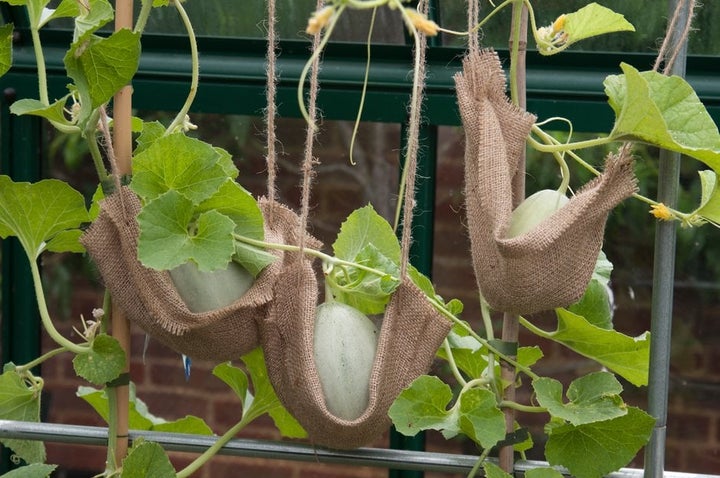
Melon plants need regular maintenance to grow and crop well. Care tasks include training, supporting, watering, pinching out shoots and the removal of some fruits. Careful attention is needed to ensure successful flower pollination, especially when plants are grown under cover.
Training and supporting
Melons can either be grown up supports or allowed to trail on the ground. Growing them vertically means they take up little ground space, which is particularly useful in a greenhouse. Suitable supports include sturdy bamboo canes, netting, vertical strings or trellis, which their tendrils can around. Melons can make large plants and mature fruits are heavy, so make sure the supports are strong and well anchored.
Decide how you want to train the stems from the start – there are several options. When growing vertically, you can have one main stem growing up the support, then train the side-shoots horizontally and the tips after seven to nine leaves have formed, to encourage flowering shoots to develop. Alternatively, once the young plant has five leaves, you can pinch out the growing tip to encourage side-shoots. When these appear, keep the four strongest and remove any others. These shoots can then be grown up supports or can trail on the ground. If growing in a large coldframe, arrange the four shoots in an X-shape. If growing under a long tunnel , send two shoots in each direction.
Watering
Aim to keep the soil or potting evenly moist but not saturated. When watering, avoid wetting the leaves, as that can encourage fungal diseases. Use rainwater from a butt whenever possible, and water at cooler times of the day, ideally in the morning.
Melon plants grown undercover should be watered regularly, especially when fruits are forming. During hot spells, they may need watering daily.
Outdoor plants growing in the ground should need less regular attention, especially if you the soil, but will still need watering in dry weather in order to grow and crop well.
Mulching and feeding
Lay a 5-7.5cm (2-3in) layer of over the soil around the base of melon plants to help hold moisture in the ground, reduce the need for watering, and deter weed . Use well-rotted organic matter, such as home-made garden . Leave a gap around the base of the stem to help prevent rotting.
Melons grown in containers or growing bags benefit from an organic-based, general liquid feed every 10-14 days in early to mid-summer. When the fruits reach the size of walnuts, switch to a high-potassium liquid feed every 10-14 days. Melons grown in prepared ground may not need additional feeding, but if growth is slow, you can feed as above.
Stop feeding and reduce watering when the fruits start to ripen and the foliage dies back in late summer.
Temperature
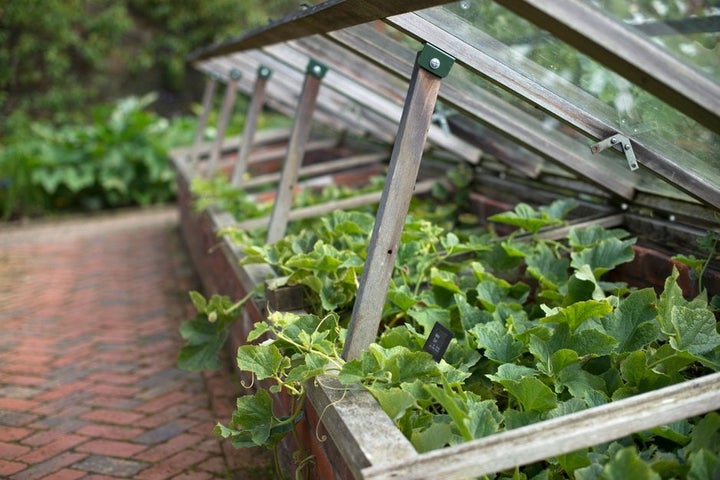
Melons grow well at about 25°C (77°F). Greenhouses can get extremely hot in sunny weather, so put up shading if necessary to reduce temperatures and prevent leaf scorch. Increase the in hot weather too, by opening greenhouse doors and vents, as well as the ends of tunnel cloches and the roof of coldframes.
Pollination
Melons are primarily insect-pollinated, with bees serving as key pollinators. Opening up tunnel cloches, coldframes and greenhouse doors and vents during the day allows pollinating insects access to flowers. However, bear in mind that once the first fruit starts to form, this can inhibit further fruit formation – to avoid this, you could wait until the plant is in full flower, then ventilate to allow insects in.
When growing under cover, pollination can be poor even with vents open, so it’s often best to hand pollinate as well. Melons produce separate male and female flowers, so you need to transfer pollen from a male flower to a female flower for a fruit to develop. It’s easy to recognise a female flower, as it has a small fruitlet behind it, while male flowers do not. Pick off a fully open male flower and carefully remove the petals to expose the pollen-bearing anthers. Then gently press the male flower into the centre of open female flowers – one male flower will pollinate several female flowers. Alternatively, you can use a small paint brush to transfer the pollen – gently dab the pollen from the centre of a male flower into the centre of up to four female flowers.
Fruit care
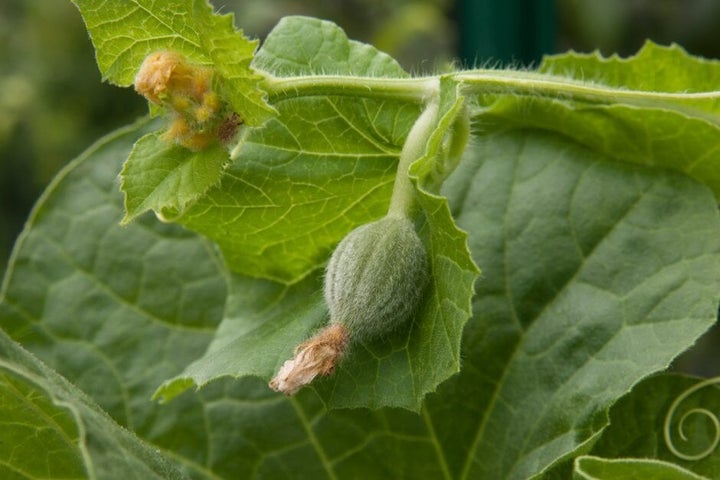
Reducing the number of melons on each plant gives the remaining fruits a better chance of reaching a good size and ripening. When young fruits are about 2.5cm (1in) in diameter, select the best one or two on each side-shoot and remove all other flowers and fruit. Then the tip of each side-shoot two or three leaves beyond the fruits. Remove any new growth that forms beyond this point, so all the plant’s energy goes into the fruit.
Aim for four to six fruits on a greenhouse plant and up to four on an outdoor plant, which is usually the maximum number that will ripen by the end of the season. If the stems are trailing on the ground, place a tile or piece of wood under developing fruits to prevent discoloration or rotting. If the stems are climbing, you may need to provide extra support for the fruits as they swell and get heavier. Netting or hessian suspended from the supports, like a hammock, usually works well. Put cloches or over outdoor plants by late summer, to keep them going as long as possible, so their fruits can ripen. Otherwise the plants will start to die as soon as night temperatures drop.
Harvesting
Melons grown in a greenhouse will ripen from late July through into early autumn. Most outdoor fruits won’t ripen until late summer, and the cropping season will be shorter, as plants will start to die once night temperatures dip. Keep cloches or crop covers handy to protect plants if cooler weather is forecast. Fruits are ready to harvest when they produce their characteristic melon fragrance and the stalk begins to crack.
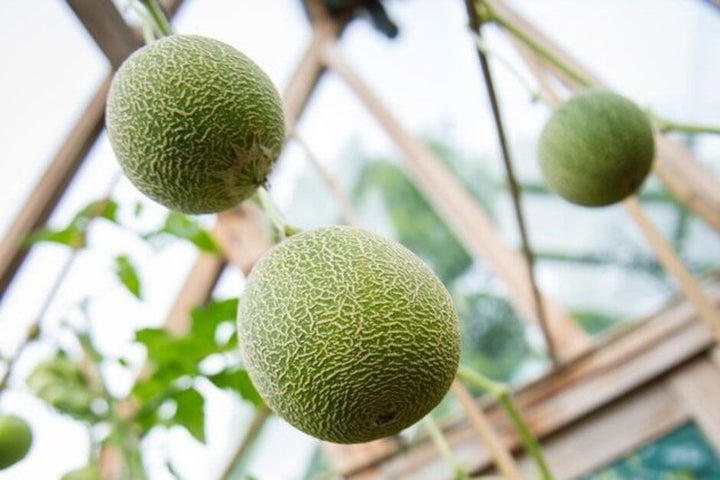
Problem Solving
Melons can be challenging to grow successfully in the UK. They are tender and need warm temperatures to germinate, thrive and crop well. They also require a regular supply of water, especially when the plants are flowering and the fruits begin to swell. For the best chances of a successful crop, grow them in a greenhouse or polytunnel and choose a variety suitable for the UK.
Melons are closely related to cucumbers, courgettes and pumpkins, and can suffer from many of the same problems, including mosaic virus. They enjoy high and are susceptible to red spider mites if the atmosphere gets too dry. Periods of drought stress can make them more susceptible to powdery mildew. Also protect young plants from slugs and snails. See ourguide to courgette problems for more tips.
Common Problems

Courgette, marrow, pumpkin and squash problems
Courgettes, marrows, pumpkins, squashes and other members of the cucurbit family are fun to grow. It can be worrying, then, when problems strike. Know...


